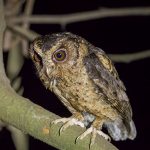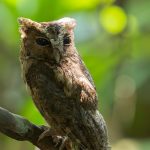There have always been questions about whether the tiny island of Singapore having any endemic or near-endemic bird species. After all, it sits in a high-biodiversity region. For a very long time, the answer is no.
Nonetheless a few publications, namely Owls of the World (König & Weick, 2008) and Owls of the World: A Photographic Guide (Mikkola, 2012) suggest that there is such a bird named Singapore Scops Owl.
In Singapore, the resident scops owl is the Sunda Scops Owl (Otus lempiji). The subspecies in the southern Malaysia and Singapore is called cnephaeus. What is proposed by these publications is that due to the difference in the vocalizations of the owls in Singapore, they are distinct from the normal Sunda Scops Owl elsewhere in the region. Hence an elevation to a species level and renaming to Singapore Scops Owl (Otus cnephaeus)
Does this claim stand to scientific scrutiny?
In the OrientalBirding mailing-list, this is ornithologist from NUS, Dr. Frank Rheidnt’s reply:
I think it’s important to point out that König & Weick’s “Singapore Scops Owl” is – with all probability – a mistaken proposal and will not stand the scrutiny of vocal or molecular research. Geographic boundaries of many of the proposed subspecies names will probably have to be redrawn, and I suspect more than one of them may result invalid. This is for a variety of reasons.
(1) Carving the Singapore Scops Owl out of the Sunda Scops Owl as proposed would result in an extremely unusual biogeographic pattern that is not paralleled by any other bird taxon. There has never really been a substantial biogeographic boundary between (S Pen Mal + Singapore) versus (rest of Sundaic region) in the last couple of million years that would have facilitated speciation of such an owl.
(2) The Sunda/Collared/Indian Scops Owl lineage – members of which share near-identical mtDNA sequences (Fuchs et al.) – is vocally very complex and variable. Any conclusion based on vocal characters should aim to include many different samples per taxon. Just by looking at the diversity of recordings available at public internet collections, one can see that calls characteristic of Sunda (O. lempiji) can be heard far into the monsoonal latitudes of Thailand, where Collared (O. lettia) occurs. I have less experience with the border region between O. lettia and O. bakkamoena, but I wouldn’t be surprised if there were a vocal cline there as well. In my assessment, the first step for field ornithologists would be to figure out if Sunda Scops (O. lempiji) indeed merits species rank before trying to carve out any more species from it.
So there you have it. Astute reader will know the Betteridge’s law of headlines. Nonetheless, regardless whether it is Singapore Scops Owl or Sunda Scops Owl, it is our resident owl, and is one that can be commonly found and heard. They are normally resident in forests, mangroves, secondary growth, plantations and even parks. Seeing them on the other hand will take some effort as they are nocturnal birds.
Photo Gallery
- A Sunda Scops Owl perching low in a garden. Taken at night with a torchlight illumination.
- A close-up of a Sunda Scops Owl from Macritchie Reservoir trail. This was taken during the day. I discovered the owl after a squirrel gave its position away.
- A Sunda Scops Owl looking warily at me, but as it was daytime, it was not very active. There is a small body of water separating it from me.
- An owl’s head can turn around 180 degrees, and this is an example of that.



